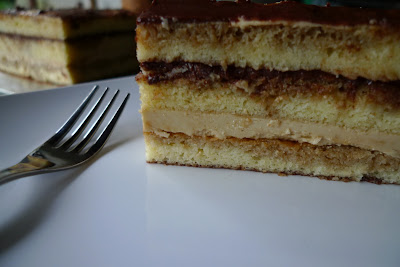Pancakes for breakfast is a rare and special occasion for me. It's not everyday I get to wake up early to prepare a nice warm breakfast (toasts don't count). I'm also never out for breakfast unless I'm on a holiday. During my last holiday in Sydney, I had pancakes two breakfasts in a row!
Now, I like my pancakes sweet. Whether it's blueberry, chocolate or ya ol' regular stack of plain pancake, it always taste best when there's maple syrup to sweeten things up. I understand that some like theirs savoury but the idea of having pancakes with bacon and eggs somehow just turns me off.
Now, I like my pancakes sweet. Whether it's blueberry, chocolate or ya ol' regular stack of plain pancake, it always taste best when there's maple syrup to sweeten things up. I understand that some like theirs savoury but the idea of having pancakes with bacon and eggs somehow just turns me off.
Once upon a time, I never did like pancakes.. I can still recall as a kid, eating a banana pancake that was flat, rubbery and spongy! Not something you would describe pancakes. Haha. But because of my traumatic childhood pancake experience, I never ordered pancakes whenever I was out for breakfast. Till that one faithful day at a hotel in Chang Mai.
It was at that hotel's breakfast that my perception of pancakes changed. Our complimentary breakfast came as a set and pancakes was a part of it. Three small fluffy pancakes dusted with icing sugar served with maple syrup at the side. After that first bite, I was totally sold! Since then, I moved on from instant pancake mix (the kind which comes in a bottle where you add water and shake it till is looks like pancake batter) to making my own. I must admit, those bottled pancake mix are pretty decent. Especially on days when I can't be bothered to make my own.
The secret to a good pancake is a lumpy batter. An over mixed, smooth batter is not better. Don't be too concerned about that unmixed bit of flour. Remember, lumps = good pancakes! Another sure win tip to a good pancake is buttermilk. The acid in the buttermilk will react with the baking soda to produce air bubbles which makes your pancake light and fluffy. To those who love chemistry as much as I do:
NaHCO3 + H+ → Na+ + CO2 + H2O
*If you don't have buttermilk in the fridge, don't worry. You can simply make it at home with either vinegar or lemon juice. To make a cup of buttermilk, just add 1 tablespoon of vinegar/lemon juice to about 1 cup of milk. Let it sit for 5min and viola! Buttermilk is born.
The secret to a good pancake is a lumpy batter. An over mixed, smooth batter is not better. Don't be too concerned about that unmixed bit of flour. Remember, lumps = good pancakes! Another sure win tip to a good pancake is buttermilk. The acid in the buttermilk will react with the baking soda to produce air bubbles which makes your pancake light and fluffy. To those who love chemistry as much as I do:
NaHCO3 + H+ → Na+ + CO2 + H2O
*If you don't have buttermilk in the fridge, don't worry. You can simply make it at home with either vinegar or lemon juice. To make a cup of buttermilk, just add 1 tablespoon of vinegar/lemon juice to about 1 cup of milk. Let it sit for 5min and viola! Buttermilk is born.
The recipe below is by one of my favourite chef, Alton Brown, who is the creator/host of the popular Good Eats show. It was his show which got me interested in cooking as a kid. I used to watch the show on TV everyday after school. Here's the pancake episode if you're interested.
Alton Brown's "Instant" Pancakes
Makes 12 pancakes
Ingredients
"Pancake mix"
6 cups (750g) all-purpose flour
1 1/2 teaspoons baking soda (check expiration date first)
3 teaspoons baking powder
1 tablespoon kosher salt
2 tablespoons sugar
Combine all of the ingredients in a lidded container. Shake to mix.
Use the mix within 3 months
2 eggs, separated
2 cups (470ml) buttermilk
4 tablespoons (55g) melted butter
2 cups (250g) "Instant" Pancake Mix, recipe above
1 stick (110g) butter, for greasing the pan
2 cups fresh fruit such as blueberries, if desired
Heat an electric griddle or frying pan to 180 degrees C. (If you are using a frying pan, place a few drops of water onto the pan. If the droplets are happily dancing on the surface, the pan is ready)
Whisk together the egg whites and the buttermilk in a small bowl. In another bowl, whisk the egg yolks with the melted butter.
Combine the buttermilk mixture with the egg yolk mixture in a large mixing bowl and whisk together until thoroughly combined. Pour the liquid ingredients on top of the pancake mix. Using a whisk, mix the batter just enough to bring it together. Don't try to work all the lumps out.
Lightly butter the griddle. Wipe off thoroughly with a paper towel. (No butter should be visible.)
Gently ladle the pancake batter onto the griddle and sprinkle on fruit if desired. When bubbles begin to set around the edges of the pancake and the griddle-side of the cake is golden, gently flip the pancakes. Continue to cook 2 to 3 minutes or until the pancake is set.
Serve immediately or remove to a towel-lined baking sheet and cover with a towel.













